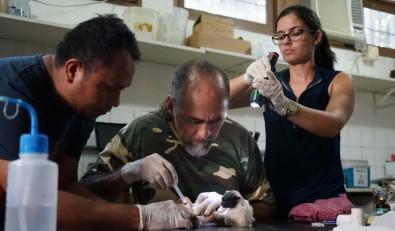Scientists will monitor areas in which these diseases are endemic, such as São Paulo, the Amazon, the Pantanal and Panama, to investigate the factors that trigger outbreaks (monkey being examined in Manaus área.

Credit: CREATE-NEO
By Maria Fernanda Ziegler | Agência FAPESP – Yellow fever was the first human disease to have a licensed vaccine and has long been considered important to an understanding of how epidemics happen and should be combated. It was introduced to the Americas in the seventeenth century, and high death rates have resulted from successive outbreaks since then. Epidemics of yellow fever were associated with the slave trade, the US gold rush and settlement of the Old West, the Haitian Revolution, and construction of the Panama Canal, to cite only a few examples.
Centuries after the disease was first reported in the Americas, an international team of researchers will embark on a groundbreaking study to develop models that predict epidemics of yellow fever and other diseases caused by mosquito-borne arboviruses such as dengue, zika, and chikungunya.
“Knowledge of these diseases, their cycles ,and the possibilities of new outbreaks is very well-established, but we still lack a systematic understanding of how to predict when outbreaks will occur. Our goal is to create predictive models to help monitor and combat outbreaks, protect the public, and develop a deeper understanding of the combination of factors that leads to epidemics,” said Maurício Lacerda Nogueira, a professor at the São José do Rio Preto Medical School (FAMERP) in the state of São Paulo, Brazil, and a member of the CREATE-NEO project funded by the US National Institutes of Health (NIH).
The new study is part of a Thematic Project supported by FAPESP to monitor the mosquito population in the urban area of São José do Rio Preto and the monkey and mosquito populations in the transition zone between rural and urban Manaus, the Amazonas state capital.
In addition to FAMERP, the Brazilian research centers that are participating in the initiative include the National Institute for Research on the Amazon (INPA), the Federal University of Mato Grosso (UFMT), the Federal University of Amazonas (UF AM), and the Heitor Vieira Dourado Foundation for Tropical Medicine (FMT-HVD). Participants located elsewhere include the University of Texas Medical Branch (UTMB), New Mexico State University (NMSU), the Massachusetts Institute of Technology (MIT), and Cary Institute of Ecosystem Studies in the US, and the Gorgas Memorial Institute for Health Studies (ICGES) in Panama, among others.
An article written by the researchers to mark the project’s inception is published in Emerging Topics in Life Science, reviewing the factors that influence the potential re-emergence of yellow fever in the Neotropics.
“Deforestation, seasonal variations in rainfall and non-human primate populations are all factors that influence outbreaks, but we need to know the tipping-point for each one, and to find that out we’ll develop predictive models based on research and monitoring conducted in arbovirus hotspots in São Paulo, Amazonas and the Pantanal in Brazil, and in Panama,” Nogueira said.
The history of yellow fever shows that outbreaks occur at intervals of between seven and ten years. “Brazil has many arboviruses, with outbreaks and even epidemics in progress all the time,” said Livia Sacchetto, also a researcher at FAMERP and a member of CREATE-NEO.
From forest to city and vice-versa
According to Sacchetto, the project also aims to find out more about spillovers and, if possible, anticipate these outbreaks in which arboviruses jump from humans to animals or vice-versa. Dengue, zika, and chikungunya are transmitted to humans and non-human primates by infected Aedes aegypti mosquitoes. In the case of yellow fever, A. aegypti is the urban vector but mosquitoes of a different genus (Haemagogus) are responsible for transmission in the countryside (sylvatic cycle).
Despite the existence of a highly effective vaccine since 1937, and no reported cases caused by urban transmission since 1942, sylvatic outbreaks of yellow fever frequently spill over into cities. “Many people and monkeys die of yellow fever in Brazil and other parts of the Americas, as well as in Africa,” Sacchetto said. “Despite the vaccine and progress in controlling transmission of the disease, we continue to see cases emerging from the sylvatic cycle. The virus is endemic in part of Brazil, with persistent circulation between mosquitoes and non-human primates, which are its primary hosts.”
This enzootic cycle is far from easy to control. “Once established, the enzootic cycle ensures that the virus stays in forests or other rural areas, but it can spread to a city via accidental infection of a human,” she said. Circulation of the virus in cities raises concerns about a return of the urban cycle involving transmission by A. aegypti. “Hence the importance of epidemiological surveillance studies and maintenance of large-scale vaccine coverage to control outbreaks.”
Predictive models for arboviruses also take into account climate change and urbanization destroying native vegetation. “We have active cases of yellow fever in both non-human primates and humans in the Southern states of Paraná and Santa Catarina. This hasn’t happened for several decades,” Nogueira said.
In Africa, from which yellow fever came to the Americas, most cases of the disease occur in the sub-Saharan region. Urban yellow fever is a major public health concern, with frequent outbreaks that are hard to predict.
In the Americas, as the authors of the review article note, yellow fever has historically been reported from northern Panama to northeastern Argentina. In recent years, most cases have occurred in the Amazon Basin during the rainy season, when population densities of Haemagogus mosquitoes are at their highest, but the number of reported cases following sylvatic spillover has increased in Peru, Bolivia, and Paraguay, as well as Brazil.
The article “Re-emergence of yellow fever in the Neotropics – quo vadis?” (doi: 10.1042/ETLS20200187) by Livia Sacchetto, Betania P. Drumond, Barbara A. Han, Mauricio L. Nogueira and Nikos Vasilakis can be read at: portlandpress.com/emergtoplifesci/article/4/4/411/227095/Re-emergence-of-yellow-fever-in-the-neotropics-quo.
Media Contact
heloisa reinert
[email protected]
Original Source
https:/
Related Journal Article
http://dx.




